Step-Up Parenting Plans
A child's needs change as they get older, and a step-up parenting plan evolves with them. It eases your child into spending more time with a noncustodial parent they don't know well or haven't recently spent significant time with. Some states like Ohio and Texas call these arrangements phased-in parenting time.
Parents can negotiate a step-up parenting plan, or one parent could propose the plan to the court. In either case, the judge will only approve the plan as part of the final custody order if it's in the child's best interest.
What is a step-up parenting plan?
A step-up parenting plan adjusts visitation over time. It's a good option for any family who wants to plan ahead and help their child adapt to living in two households. They're most common in cases involving:
- Infants and toddlers
- Parents who were never married to each other
- Estranged parents
- A noncustodial parent with a history of crime, violence or substance abuse
The specifics of the plan depend on the child's age, how familiar they are with the noncustodial parent and the noncustodial parent's behavior.
Noncustodial parents may worry they'll always be stuck with the same share of parenting time. With a step-up parenting plan, they're guaranteed to get more time as they move up each "step" — so long as they meet the outlined requirements.
For example, the noncustodial parent might have to pass random drug tests or attend counseling to move up a step. Most importantly, the child must be comfortable enough to spend more time around the parent. Any attempt by the custodial parent to interfere with this progression without just cause (e.g., protecting the child from harm) violates the court order.
Ultimately, parents are working toward a standard schedule that will stay in place until the child turns 18.
Benefits of a step-up parenting plan
- Eases the child into spending time with the noncustodial parent so it's not as stressful
- Gives the noncustodial parent and the child time to develop a healthy relationship
- Ensures the noncustodial parent is fit to care for the child
- Increases the likelihood of equal shared parenting as parents learn to cooperate
- Eliminates the need to return to court to modify the order as the child ages
Sample step-up parenting plan
To get an idea of how to structure your plan, explore the sample plan below made with the Custody X Change app.
Often, courts let you use any format for your parenting plan. Even if yours requires you to use their template, they typically allow parents to attach another plan with additional information. This can be helpful if your court's template doesn't work well for stepping up.
Custody X Change has all the tools you'll need to build a step-up plan. Start by creating your parenting time schedules. Then make your parenting plan with custom provisions that set the conditions for moving to the next step.
We've created a hypothetical scenario to illustrate how a step-up plan works. The noncustodial parent, Jamie, has not seen their 7-year-old child in two years. The custodial parent, Susan, currently has sole physical custody. The end goal is for Jamie and Susan to have joint physical custody.
Basic personal information
The top of your plan should include the parents' and child's full names, your case number and other basic information as shown here.
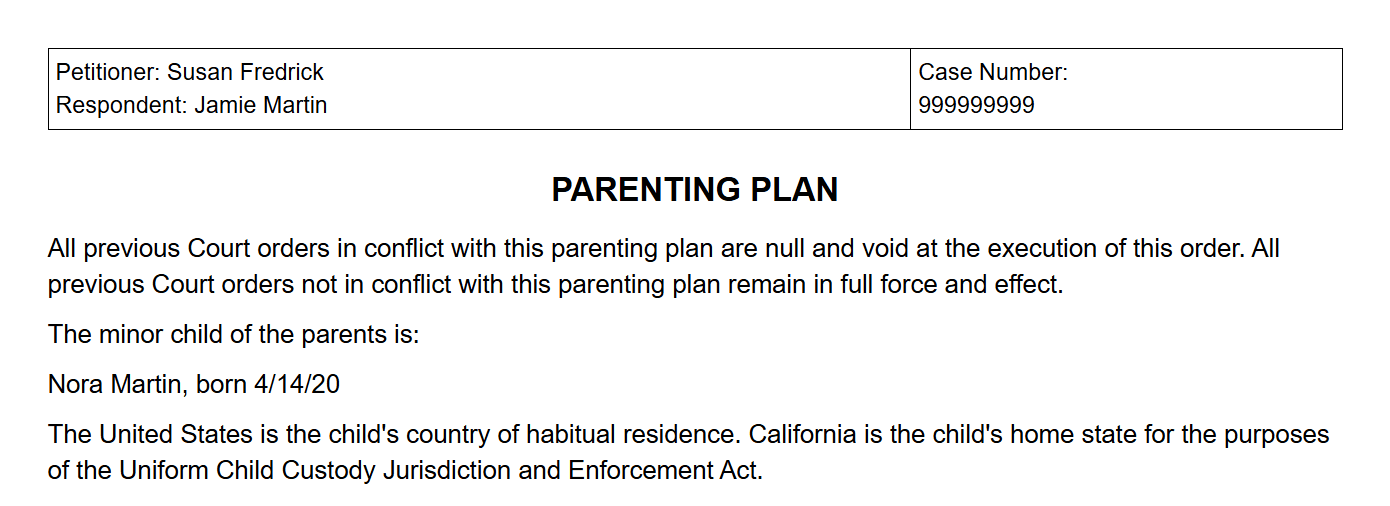 You can customize this with Custody X Change.
You can customize this with Custody X Change.
Schedules
You'll need a written schedule for each step of your plan. Research child custody schedules for your child's age group to get ideas. Custody X Change automatically translates the visual schedules you create to proper legal language.
You'll begin by creating your first schedule. Since Jamie hasn't seen their school-age child in two years, it's important they start with short, supervised visits.
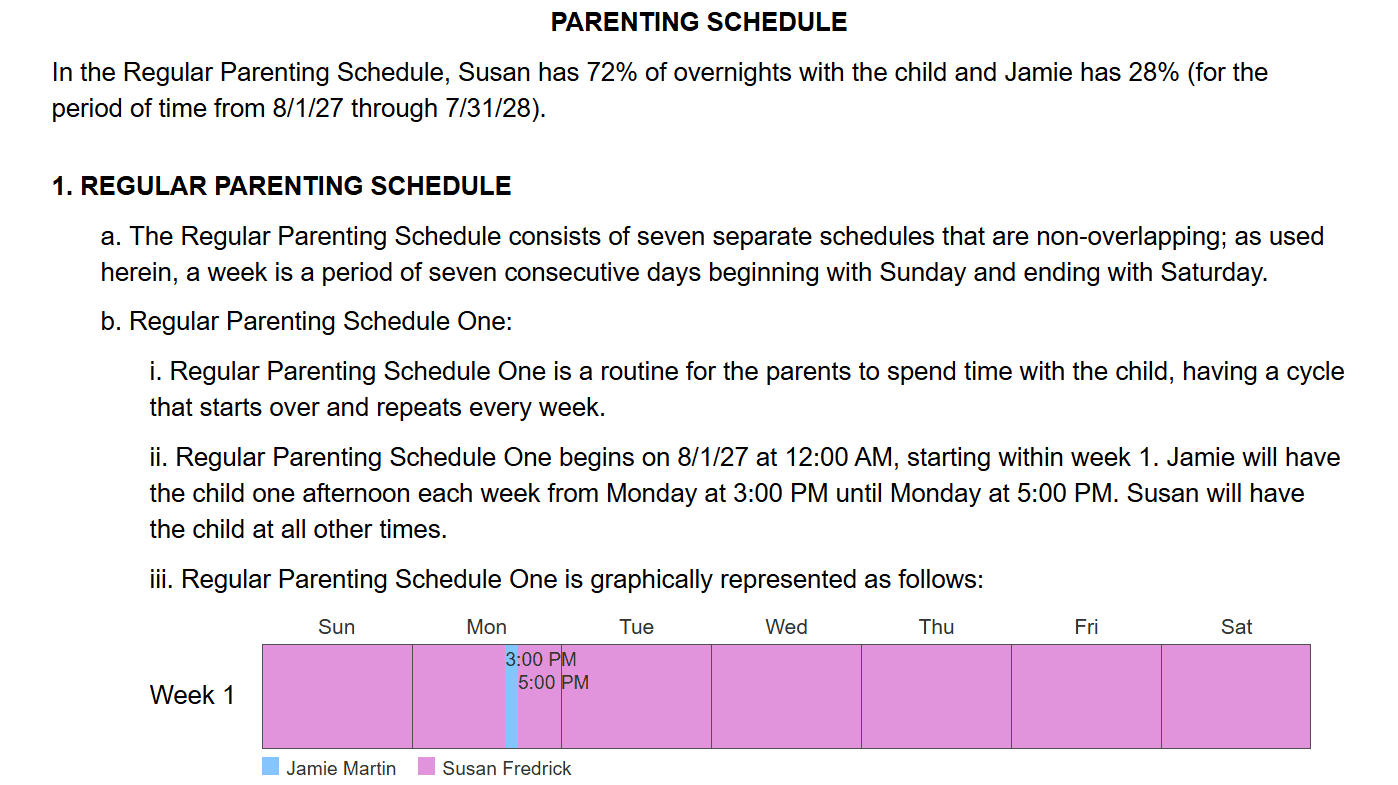 You can customize this with Custody X Change.
You can customize this with Custody X Change.
When you enter your next schedules, choose start dates that seem about right. If a date will depend on the noncustodial parent meeting conditions, write a provision to explain that it may move. (See Steps below for how to do this.)
At Step 2, Jamie's parenting time increases to twice a week.
 You can customize this with Custody X Change.
You can customize this with Custody X Change.
There isn't a minimum or maximum number of schedules and steps you should have. It all depends on what best suits your child and allows the noncustodial parent sufficient time to prove they're ready to take on a more active parenting role.
In our sample plan, it takes seven steps to get to the standard schedule that will stay in place until the child turns 18 (or until it's modified).
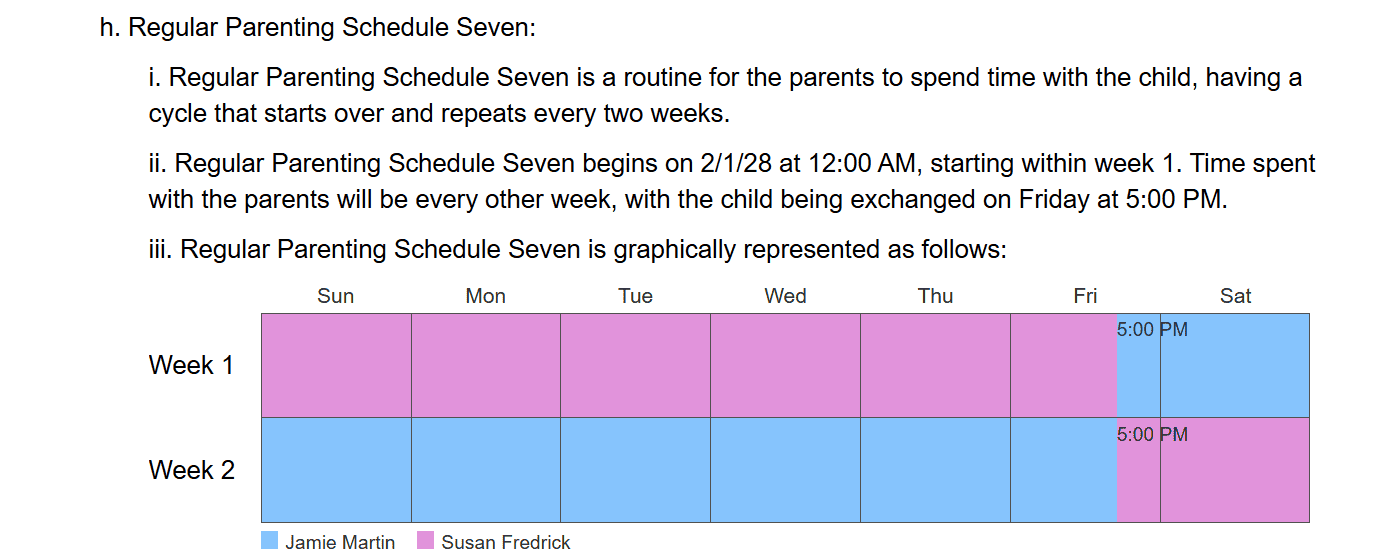 You can customize this with Custody X Change.
You can customize this with Custody X Change.
Type of custody
Specify the type of custody you'll have now and whether it will change as your plan progresses.
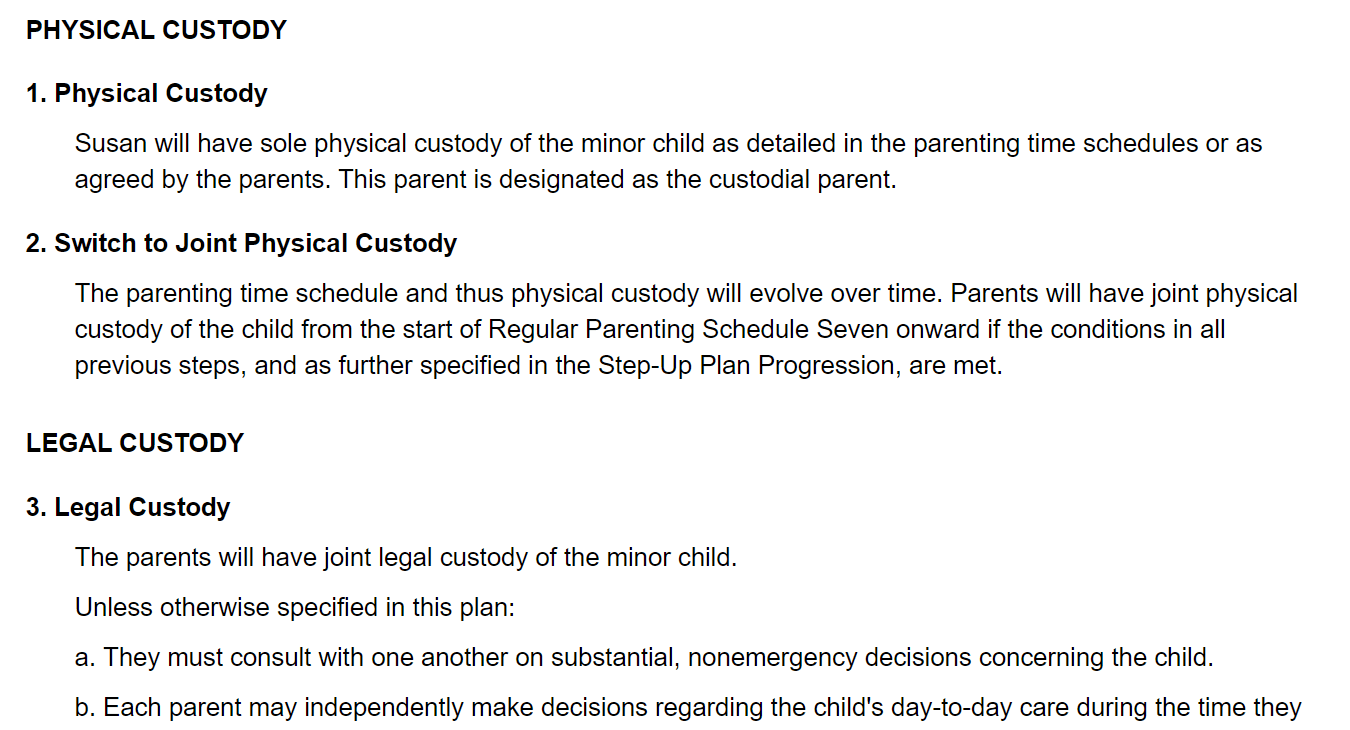
Steps
Identify and describe each step of your plan.
Start with a custom provision explaining how the plan will progress generally and the guidelines (if any) that will apply across all steps. You might call it "Step-Up Plan Progression."
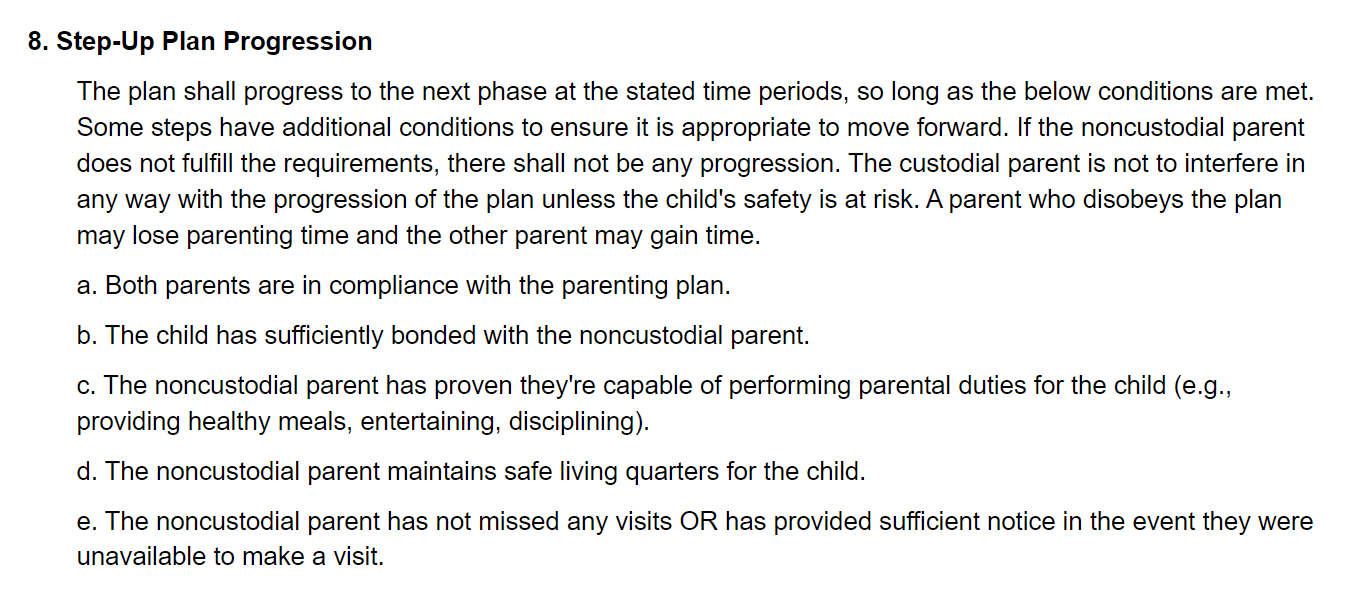
Then you can add a custom provision for each step. Name the schedule you'll follow, and the conditions under which the plan can proceed to the next step. If failure to meet a condition would delay parents' progress to the next step, say so clearly and explain how the start date will move.
In this example, Jamie must attend a parenting class and counseling to get more parenting time.
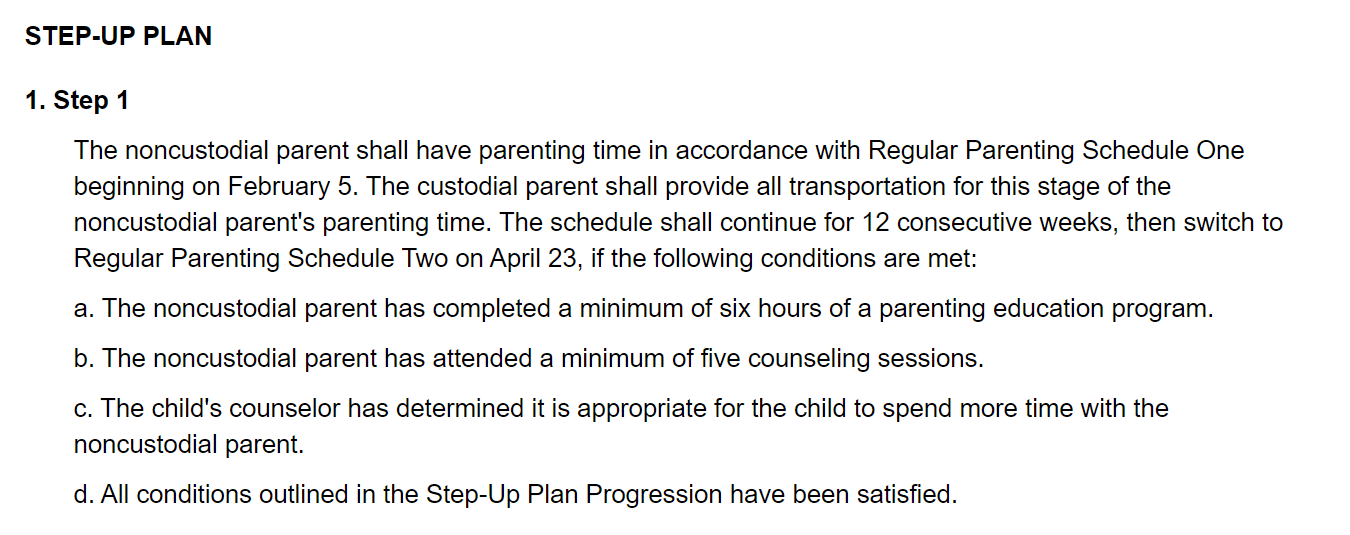
Depending on your circumstances, the next steps may have fewer requirements.

In our sample plan, the final step has no more specific conditions and instead refers back to the "Step-Up Plan Progression."

Other provisions
Add as many other provisions to your plan as you'd like. Generally, the more you decide on ahead of time, the less confusion and conflict you'll face later.
Common provisions step-up parenting plans include:
- Exchanges
- Supervised visitation
- Changes to parenting time
- Communication
- Child rearing
- Counseling
- Alcohol, tobacco and drugs
Supervised visits are common in step-up plans since it might be unsafe or uncomfortable for the child to be alone with the noncustodial parent at first. This arrangement also helps the custodial parent keep track of the child's location during visits.
A supervised visit takes place with a third party present; sometimes the court requires these visits to occur in dedicated places called supervised visitation facilities.

You can agree in advance when visits will no longer require supervision.
One way to do this is to specify that, for example, Steps 1–3 will be supervised, and Steps 4 onward will be unsupervised.
Or you can devote a section of your parenting plan to describe requirements for ending supervision. Then, include language like: "Should the noncustodial parent successfully fulfill the requirements outlined in [Section #], visits from [Date] onward will be unsupervised."

Signatures
To complete your plan, each parent should sign it to confirm they agree to the terms.
 You can customize this with Custody X Change.
You can customize this with Custody X Change.
You can also add space for your lawyers to sign, for a notary to sign or for the parents to initial each page, depending on what your court requires.
The easiest way to make a step-up parenting plan
Step-up parenting plans are complex. Custody X Change provides you with structure — but also flexibility — so you get a plan that meets your family's needs for years to come.
It offers popular provisions to choose from and lets you add in custom provisions. Plus, you can save your plan as a Word document to make all the tweaks you want: formatting, organization, etc.
 You can customize this with Custody X Change.
You can customize this with Custody X Change.
The Custody X Change app can also help you manage your step-up parenting arrangement:
- Keep a journal to note what happens during your visits and show you've done what's required to move on to the next step.
- Track your actual parenting time to ensure you get the time you've earned with your child or to show the other parent is neglecting their time.
- Document conversations with the other parent to show when they're noncompliant.
Use the Custody X Change app's versatility to your advantage.
